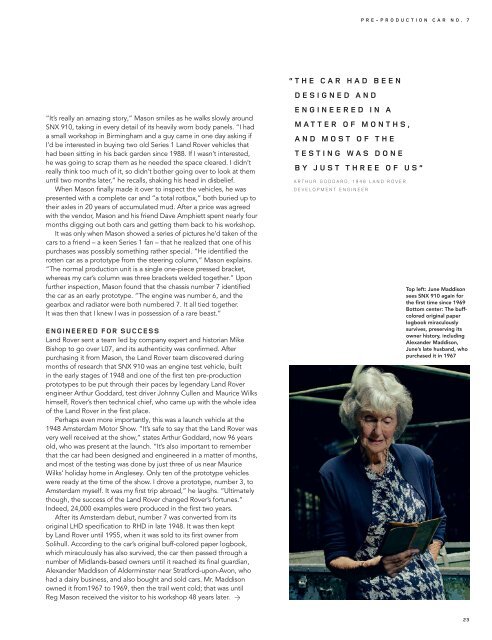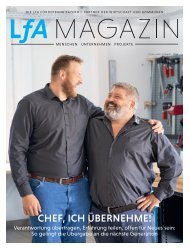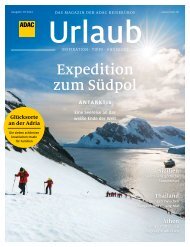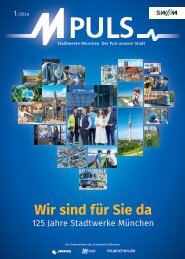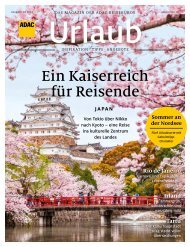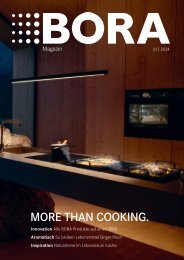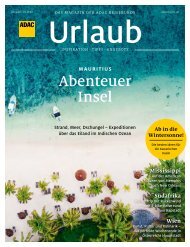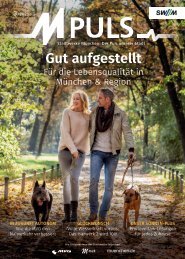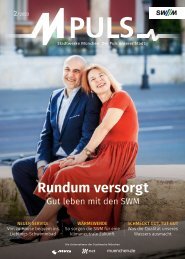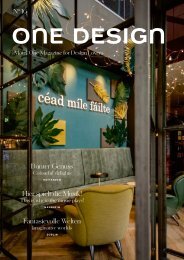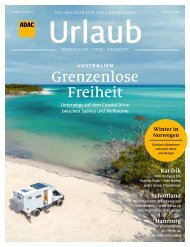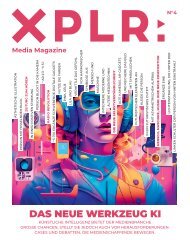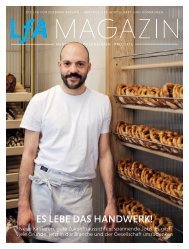ONELIFE #36 – US English
Land Rover’s Onelife magazine showcases stories from around the world that celebrate inner strength and the drive to go Above and Beyond. This special issue of Onelife marks Land Rover’s 70th anniversary – a celebration of unparalleled achievement and pioneering innovation. We bring you the incredible story of how we reunited an original 1948 car with its former owners, as well as looking back at Land Rover vehicles’ most intrepid expeditions around the globe.
Land Rover’s Onelife magazine showcases stories from around the world that celebrate inner strength and the drive to go Above and Beyond.
This special issue of Onelife marks Land Rover’s 70th anniversary – a celebration of unparalleled achievement and pioneering innovation. We bring you the incredible story of how we reunited an original 1948 car with its former owners, as well as looking back at Land Rover vehicles’ most intrepid expeditions around the globe.
You also want an ePaper? Increase the reach of your titles
YUMPU automatically turns print PDFs into web optimized ePapers that Google loves.
PRE-PRODUCTION CAR NO. 7<br />
“It’s really an amazing story,” Mason smiles as he walks slowly around<br />
SNX 910, taking in every detail of its heavily worn body panels. “I had<br />
a small workshop in Birmingham and a guy came in one day asking if<br />
I’d be interested in buying two old Series 1 Land Rover vehicles that<br />
had been sitting in his back garden since 1988. If I wasn’t interested,<br />
he was going to scrap them as he needed the space cleared. I didn’t<br />
really think too much of it, so didn’t bother going over to look at them<br />
until two months later,” he recalls, shaking his head in disbelief.<br />
When Mason finally made it over to inspect the vehicles, he was<br />
presented with a complete car and “a total rotbox,” both buried up to<br />
their axles in 20 years of accumulated mud. After a price was agreed<br />
with the vendor, Mason and his friend Dave Amphiett spent nearly four<br />
months digging out both cars and getting them back to his workshop.<br />
It was only when Mason showed a series of pictures he’d taken of the<br />
cars to a friend <strong>–</strong> a keen Series 1 fan <strong>–</strong> that he realized that one of his<br />
purchases was possibly something rather special. “He identified the<br />
rotten car as a prototype from the steering column,” Mason explains.<br />
“The normal production unit is a single one-piece pressed bracket,<br />
whereas my car’s column was three brackets welded together.” Upon<br />
further inspection, Mason found that the chassis number 7 identified<br />
the car as an early prototype. “The engine was number 6, and the<br />
gearbox and radiator were both numbered 7. It all tied together.<br />
It was then that I knew I was in possession of a rare beast.”<br />
ENGINEERED FOR SUCCESS<br />
Land Rover sent a team led by company expert and historian Mike<br />
Bishop to go over L07, and its authenticity was confirmed. After<br />
purchasing it from Mason, the Land Rover team discovered during<br />
months of research that SNX 910 was an engine test vehicle, built<br />
in the early stages of 1948 and one of the first ten pre-production<br />
prototypes to be put through their paces by legendary Land Rover<br />
engineer Arthur Goddard, test driver Johnny Cullen and Maurice Wilks<br />
himself, Rover’s then technical chief, who came up with the whole idea<br />
of the Land Rover in the first place.<br />
Perhaps even more importantly, this was a launch vehicle at the<br />
1948 Amsterdam Motor Show. “It’s safe to say that the Land Rover was<br />
very well received at the show,” states Arthur Goddard, now 96 years<br />
old, who was present at the launch. “It’s also important to remember<br />
that the car had been designed and engineered in a matter of months,<br />
and most of the testing was done by just three of us near Maurice<br />
Wilks’ holiday home in Anglesey. Only ten of the prototype vehicles<br />
were ready at the time of the show. I drove a prototype, number 3, to<br />
Amsterdam myself. It was my first trip abroad,” he laughs. “Ultimately<br />
though, the success of the Land Rover changed Rover’s fortunes.”<br />
Indeed, 24,000 examples were produced in the first two years.<br />
After its Amsterdam debut, number 7 was converted from its<br />
original LHD specification to RHD in late 1948. It was then kept<br />
by Land Rover until 1955, when it was sold to its first owner from<br />
Solihull. According to the car’s original buff-colored paper logbook,<br />
which miraculously has also survived, the car then passed through a<br />
number of Midlands-based owners until it reached its final guardian,<br />
Alexander Maddison of Alderminster near Stratford-upon-Avon, who<br />
had a dairy business, and also bought and sold cars. Mr. Maddison<br />
owned it from1967 to 1969, then the trail went cold; that was until<br />
Reg Mason received the visitor to his workshop 48 years later.<br />
“THE CAR HAD BEEN<br />
DESIGNED AND<br />
ENGINEERED IN A<br />
MATTER OF MONTHS,<br />
AND MOST OF THE<br />
TESTING WAS DONE<br />
BY J<strong>US</strong>T THREE OF <strong>US</strong>”<br />
ARTHUR GODDARD, 1948 LAND ROVER<br />
DEVELOPMENT ENGINEER<br />
Top left: June Maddison<br />
sees SNX 910 again for<br />
the first time since 1969<br />
Bottom center: The buffcolored<br />
original paper<br />
logbook miraculously<br />
survives, preserving its<br />
owner history, including<br />
Alexander Maddison,<br />
June’s late husband, who<br />
purchased it in 1967<br />
23


